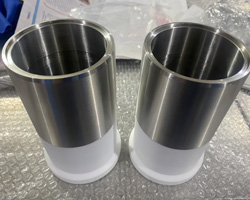
- English
- Español
- Português
- русский
- Français
- 日本語
- Deutsch
- tiếng Việt
- Italiano
- Nederlands
- ภาษาไทย
- Polski
- 한국어
- Svenska
- magyar
- Malay
- বাংলা ভাষার
- Dansk
- Suomi
- हिन्दी
- Pilipino
- Türkçe
- Gaeilge
- العربية
- Indonesia
- Norsk
- تمل
- český
- ελληνικά
- український
- Javanese
- فارسی
- தமிழ்
- తెలుగు
- नेपाली
- Burmese
- български
- ລາວ
- Latine
- Қазақша
- Euskal
- Azərbaycan
- Slovenský jazyk
- Македонски
- Lietuvos
- Eesti Keel
- Română
- Slovenski
- मराठी
- Srpski језик
HY introduces you to the complete die-casting process (Part 1)
What is die casting?
Die casting is a widely used long-term metal casting process in which molten metal is melted into a "mold" under pressure of 0.7 to 700 MPa, where it solidifies into a metal casting. Die castings, sometimes called pressure die castings, are used in car casings, electrical components and toys.
Casting mold example
The non-ferrous metals aluminum, zinc, copper, magnesium, lead and Inconel are widely used to produce strong, high-quality, complex components. Different chemical elements are added to the molten metal to change the original chemical composition of the metal to meet the needs of different product parts.Depending on the part's complexity, size and material, the final part produced can be a single casting or multiple castings. There is a single cavity, multiple cavities, or even multiple different part cavities in the mold, or a set of mold units formed by multiple molds combined together.
The history of die casting molds
The process was introduced in the mid-19th century and was first used to manufacture parts for the printing industry. Subsequently, it has become one of the most critical manufacturing processes. With the advancement of modern science and technology, it has become one of the more and more important manufacturing processes and is widely used in the automotive industry.
As shown below, die casting can produce parts with complex features and excellent surface finishes. It can also compete with other manufacturing techniques such as sheet metal stamping, forging and other casting processes.


Advantages and Disadvantages of Die Casting Process
Die casting advantages
Die-cast parts are cheaper and the quality produced is stable and consistent. They are one of the parts suitable for mass production processes. Semi-automated or fully automated production processes reduce labor costs. Complex precision can be cast with ease, with part sizes ranging from 25g to 25Kg.Due to the high pressure used in the process, the wall thickness of the parts can be as thin as 0.38 mm. Because the molten metal cools rapidly at the mold walls, the casting has a fine-grained crust that is very strong and hard. Therefore, as the wall thickness increases, the strength of the die-cast parts increases. Bearings that originally required processing were produced without additional processing and directly produced a smooth surface. HY die casting can produce products with smooth and clean surfaces at high speed, with almost no need for post-processing. Excellent part dimensional accuracy and good surface finish at - 0.8-3.2 um Ra.
The die casting process is not only used for large parts, smaller parts can also be produced using multi-cavity die casting molds or micro die casting.
Disadvantages of die castings
Due to the high cost of equipment, die castings are suitable for mass production of many metals, but they are not suitable for high melting point metals and alloys. They are also not suitable for ferrous metals such as stainless steel, carbon steel, and alloy steel that are prone to rust.The mold cost is high and the design delivery time is relatively long. Changing part designs is time-consuming and expensive, so prototyping the part requires confirming all details with the customer before proceeding to die-cast production.
Die casting type
Hot chamber process and cold chamber process
The two basic types of die casting machines are hot chamber die casting machines and cold chamber die casting machines. Variations on these two important types of casting processes are vacuum, extrusion, low pressure, and semi-solid die casting. Different die casting processes are selected based on part material, geometry, size and complexity.


Hot chamber process
The hot chamber process is sometimes called the hot mold or gooseneck casting process. In this process, the plunger and chamber of the injection mechanism are immersed in a bath of molten metal in a metal furnace and used with low melting point metals that will not chemically attack the immersed plunger assembly. When the mold closes, the plunger retracts and opens the chamber port, allowing molten metal to flow into the chamber. The plunger then seals the port while pushing molten metal through the gooseneck and nozzle into the mold cavity. After entering the mold cavity, the molten metal is held under pressure until it solidifies within the mold. Due to the higher pressure, the hot chamber process has much higher productivity than the cold chamber process. Hot chamber casting is better suited for processing metals with lower melting points, such as tin and zinc and alloys.
Advantages of hot chamber die casting
1. It offers faster production speeds – up to 18,000 runs per hour for smaller parts.
2. Produce parts with lower porosity
3. Metal inside the die casting machine can be melted, and the process produces reduced metal waste
4. Longer mold life due to low melting point
Disadvantages of hot chamber die casting
1. Cost-effective only for high-volume production
2. High melting point metals cannot be used
3. Requires high pressure range
4. Metal mobility is low, thus limiting product complexity
5. There may be ejection marks and a small amount of burrs remaining on the mold separation line.
Cold room process
In the cold chamber process, molten metal is poured into the shot sleeve or chamber portion of the injection cylinder before being pushed into the mold. Since the sleeve is not heated, the process is called a cold chamber process. Since the metal furnace is self-contained, there are no corrosion issues.
The cold chamber process begins when the molten material is transferred from the furnace to the injection chamber through the pouring hole. A hydraulic ram then seals the cold chamber port and forces the metal under pressure into the mold cavity. The pressure range is between 30Mpa and 150MPa. The process is typically used for high melting point alloys of aluminum, magnesium and copper, but can also be used to cast other metals including ferrous metals. The molten metal temperature starts at 600°C for aluminum and some magnesium alloys and rises significantly for copper- and iron-based alloys.
Advantages of cold chamber die casting
1. Can produce higher strength parts
2. Due to the increased pressure during the injection process, the density of metal castings is higher
3. Zero level is not easy to damage and reduces maintenance costs.
4. It brings superior dimensional accuracy to parts
5. The process is simple and easy to operate.
Disadvantages of cold chamber die casting
Mechanical equipment cycle times are slower than hot chamber die casting, likely due to the transfer of metal from the furnace to the chamber. During this process, levels of oxidation and other contaminants remain high, and the quality of the final part is more susceptible to contaminants.




